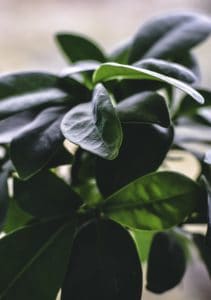Some links in the post are affiliate links and I get a commission from purchases made through some links found in the post.
The fiddle leaf fig (FLF), scientifically known as the Ficus lyrata, is an evergreen tree that grows to heights of 40 feet.
It works for indoor decoration and also looks great on patios, parking lots, and outdoor gardens.
Growing this tree should not be much of a problem as long as you water it enough and protect it from harsh winds.
Today, we look at a common problem that fiddle leaf fig lovers face – visible roots. Why do they occur, are they dangerous, and what can you do about them?
If your start seeing roots above the soil on your fiddle leaf fig plant then it is time to repot it.
Repot your fiddle leaf fig in a container which is 3-4 inches larger in diameter than the previous container. Fill the container will well draining soil that retains moisture and then water well.
Why are my Fiddle Leaf Fig Roots Showing?
Imagine this. You have a fiddle leaf fig growing in your indoors. Everything has been going great, and then you notice one thing- the fiddle leaf fig roots are showing.
Some roots have come up above the soil line, and you cannot help but wonder why this is the case.
Well, here is what you need to know about the fiddle leaf fig. It is not uncommon for the fiddle leaf fig plant to have some surface roots, which should not be a problem.
Also, the branches can produce aerial roots from time to time. In both these cases, the fiddle leaf fig roots showing should not be a source of concern.
The new roots are likely a response to the soil being too moist. You can change the watering frequency to check if this helps.
However, if you check the soil and find that some roots are poking up from below, the chances are high that your plant is rootbound.
It would be best that you start thinking of repotting it to allow for more growing space.
Do Fiddle Leaf Figs Have Aerial Roots?
Yes, generally, Ficus plants will produce aerial roots. Your Lyrata is not different.
While you might not notice it much, the branches do produce some aerial roots. However, these will not be as many as those on other kinds of Ficus, such as the Benjamina.
When Should you Repot Your Fiddle Leaf Fig?
If the roots poking out of the soil are not new and instead are old roots fighting for growing space, repotting is the best option.
Without this, the plant will not thrive and may start lacking adequate nutrients to support its growth.
However, you should note that these plants are averse to change and can go into shock when repotted.
It is thus best to understand which circumstances call for repotting and which you can let be.
Work with this question: is it more dangerous to repot the plant or to let it be?
If letting it be spells doom for its growth, get your potting mix ready. Here are good examples of when you should make a move:
Popping Roots
If the roots are popping out of the container and showing up on the surface, you need to move it to a bigger pot.
On the upside, the tree is in good health and will likely survive the move.
Animal Trouble
Suppose your pets have been using the fiddle leaf fig’s soil as a bathroom; you need to immediately move the plant.
The chemicals found in urine can damage the fiddle leaf fig roots. As such, rinse the root ball to get rid of the contaminated soil before moving it.
Also, think of a way to keep your pets away from the potting mix in the future.
Infection
If you notice brown spots spreading from leaf to leaf, you need to act immediately. These are signs of a bacterial infection that can kill your plant if it spreads enough.
Your first move should be to remove the affected leaves before moving the plant to a well-lit place.
If the spotting does not stop, you will need to repot the tree. However, the chances of its survival at this point are pretty bleak.
Root Rot
 With root rot, you have two options- you can let it be or repot it. Look at it this way.
With root rot, you have two options- you can let it be or repot it. Look at it this way.
If overwatering is the problem and the damage is not extensive, your plant can likely recover independently.
All it needs is good drainage and access to light. However, if the pot has poor drainage, the chances of the soil drying out are minimal.
In this case, the root rot can cause further damage to the plant, and you would need to repot it. We will cover root rot at a later stage.
First Transplant
When you bring the plant from the nursery, repotting might be necessary. However, this decision depends on many factors.
Think about it like this. The move to your home from the nursery is already a shock to the plant.
Moving it would add to the same and could cause it damage that could lead to death. In this case, it would be best to wait.
However, if you deem that waiting could kill the plant owing to fast drying out and lack of growing space, repot it.
Fungal Growth
When fungi start growing on the soil’s surface, you should remove them with a spoon or other suitable equipment.
Follow through with sprinkling cinnamon on the soil and moving the plant to a well-lit area.
Overwatering could be the problem in this case, and you would need to reduce the watering frequency.
Repotting should only take place where brown spots start showing on the plant’s surface.
When not to repot
Some issues will not go away, even if you repot your plant. You are best off looking for solutions to the individual problems. These include
- Dryness,
- Sunburns,
- Yellowing leaves,
- Drooping leaves,
- Edema, and
- Insect invasions
If you are enjoying this article, check out our article on how to get rid of spider mites on a fiddle leaf fig and how to care for a fiddle leaf fig outside.
How to Tell if your Fiddle Fig is Rootbound?
We covered that another reason your plant’s roots may be showing is that it has outgrown its current pot size. When this happens, we refer to the plant as rootbound.
Note that your plant needs to go up a pot size each time this happens. However, you should also note that the plants enjoy a snug feel in their pots.
Thus, instead of repotting regularly, you should look out for signs of the plant being rootbound as follows:
- Check for any roots growing on the outer edge of the pot
- Look out for any roots on the surface
- Keep an eye out for any roots coming out at the bottom of the pot
An easy way to do this is by loosening the soil in the pot and lifting the plant out of the container.
Hold on to the trunk of the tree when doing this and assess the roots. If many roots are running horizontally around the pot, you have a problem.
If any of the above checks reveal roots growing out of the pot, you need to think about repotting.
It helps to note that even when your plant is not rootbound, moving it to another pot every three years is advisable.
This move enables you to change the soil and thus supply the plant with additional nutrients. If the plant is not rootbound, you can stick to a pot of similar size to the current one.
When moving a plant, be sure to get rid of most of the old soil from the roots to give it a fresh start in the new pot.
How to Tell if Your Fiddle Leaf Fig has Root Rot?
Root rot can kill your plant if left unmanaged. It comes about when you overwater the plant, leaving the soil moist and humid most of the time.
While watering is essential, you need to allow the soil time to dry out before watering it again.
If not, root rot develops, attacking the roots then moving up to the leaves. This rot exhibits in the leaves as browning and dropping.
Also, note that root rot might not be due to overwatering, but rather, poor drainage in the pot.
Signs
How can you tell that your plant has root rot? Well, a glance at the plant may not indicate much, and the plant will look fine.
Even the soil may appear to be dry on the surface. Unbeknownst to you, the plant could be slowly dying underneath the surface. So, how can you tell that all is not well?
Start by looking at the plant in general. Have the leaves been browning or dropping? If yes, wiggle the plant out of the pot as covered under ‘rootbound’ and check for the following:
- Are the roots wet and soggy?
- Is the soil around the roots waterlogged?
- Do the roots emit a terrible smell?
If you have answered yes to the above questions, your plant has root rot.
Note that once one section of the roots starts rotting, it is only a matter of time before the entire root system gets affected.
The rot then moves to the plants, causing the death of your beloved tree.
Repotting will be necessary in most cases, where lighting and drainage are not enough to save the day.
Final Thoughts: Why are my Fiddle Leaf Fig Roots Showing?
 In most instances, roots showing up above the soil level should not be a problem.
In most instances, roots showing up above the soil level should not be a problem.
However, if the roots are old and are poking up from underneath the pot, your plant could be rootbound. Repotting would be of the essence.
When repotting the plant, only move one size up. It may be tempting to go for a bigger pot.
However, when offered more growing space, fiddle leaf figs tend to focus on expanding their root systems instead of growing more leaves.
Thus, to prevent stunted growth, keep the expansion steady. Happy gardening!
If you liked this article check out why does your fiddle leaf fig have multiple stems.
Written by: Daisy Njeri

